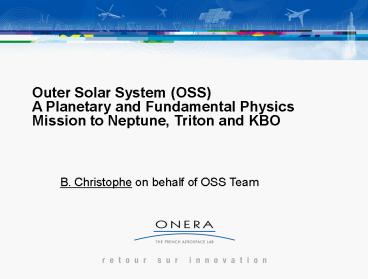Diapositive 1 PowerPoint PPT Presentation
Title: Diapositive 1
1
Outer Solar System (OSS)A Planetary and
Fundamental Physics Mission to Neptune, Triton
and KBO
B. Christophe on behalf of OSS Team
2
OSS
Planetary Physics
Fundamental Physics
Kuiper Belt Object
Argo, New Frontiers 4 Mission to Neptune, Triton
and KBO
Odyssey, Cosmic Vision 1 Mission to test deep
space gravity
Eddingtons Parameter at 10-7
NeptuneTriton
Deep SpaceGravity at 10 pm/s2
Inline with Fundamental Physics Roadmaps Advisory
Group Report
3
Deep Space Gravity Test
Accurate Navigation of S/C
Positioning
What is the S/C trajectory ?
Radio-Science
1-way or 2-ways
Laser-Science
XKa band VLBI
4
Laser Science two concepts
One-way pulsed laser (proposed by E. Samain OCA)
Two-ways continuous coherent laser (proposed by
P. Wolf SYRTE)
TESA TCL Terminal
Adaptative Optics on ground
1064 nm
Mercury Ion JPL or Horace Syrte clock
5
Deep Space Gravity Test
Accurate Navigation of S/C
Positioning
What is the S/C trajectory ?
Radio-Science
1-way or 2-ways
Laser-Science
XKa band VLBI
Non Gravitational Forces
Is S/C on a geodesic ?
DC Accelerometer lt 10 pm/s2
6
DC Accelerometer GAP
Electrostatic accelerometer MicroSTAR based on
heritage of CHAMP, GRACE and GOCE
missions (developed by ONERA)
Perfo 1 pm/s2
Bias Rejection System rotating stage with
piezo-electric motor(developed by ZARM)
For more details, see Benjamin Lenoir Poster
7
General Relativity Test / Geodesy
Deep Space Gravity (OSS)
Gravitational Wave (LISA)
Equivalence Principle (Microscope)
Orbit determination Measure of NG
Differential acceleration Drag Compensation
Variation of Laser Link Drag Compensation
GRACE / NGGM
GOCE
CHAMP
8
OSS Spacecraft
Planetary instruments UV Spectrometer 5.0
kg / 12 W High Resolution Narrow Camera 9.8 kg /
14 W IR Spectrometer / Wide Angle Camera
10.1 kg /7.5 W Radio Plasma Wave 4.7 kg
/ 7.9 W Thermal Map Imager 7.0 kg / 20
W Magnetometer 3.3 kg / 3 W Dust Particle
Detector 3.5 kg / 9 W
9
Self-gravity Management
- Accelerometer at S/C CoG
- S/C mass far from accelerometer
- Symmetry of tanks
- Membranes for ergol location
- Thermal Gauging Book Keeping for ergol mass
Self-gravity lt 14 pm/s2
10
Conclusions
- OSS was not selected by ESA for Cosmic Vision M3
- Fundamental Physics Objectives considered strong
- Planetary Objectives considered weak (flyby
instead orbiter) - RTG availability considered as a risk
- Launcher cost by US considered as a strategic
risk - OSS allows to do pioneer work on
- Merging of Fundamental and Planetary Physics as
recommended by FPRAT - Adaptative optics for 2-ways laser link
- DC accelerometer with 1 pm/s2 accuracy
- S/C design for severe self-gravity requirement
- Future works should concerns
- Integration of the DC accelerometer in the S/C
- Convincing planetary community of interest of
accelerometer
11
Acknowledgement to OSS scientific supporters
- European side PI B. Christophe (ONERA)
- CESR (France) Nicolas André
- DLR / Institute of Planetary Research (Germany)
Ralf Jaumann, Jörn Helbert, Hauke Hussmann,
Nicole Schmitz, Frank Sohl, Katrin Stephan - DLR / Institute of Space System (Germany)
Hansjörg Dittus, Marco Sharringhausen, Tim van
Zoest - GeoAzur / OCA (France) Gilles Métris, Etienne
Samain - IGEP, TU Braunschweig (Germany) Karl-Heinz
Glassmeier, Daniel Heyner - Imperial College (United Kingdom) Patrick
Brown, Michelle Dougherty, Tim Sumner - Institute for Geophysics and Meteorology / Univ.
Köln (Germany) Martin Pätzold - Institute for Planetology / Westfälische Wilhelms
Universität (Germany) Harry Hiesinger - Institut für Geowissenschaften / Max Planck
Institute (Germany) Frank Postberg, Ralf Srama - Institut für Physik und Astronomie / Universität
Postdam (Germany) Jürgen Schmidt - Instituto Superior Técnico (Portugal) Frederico
Francisco, Paulo J.S. Gil, Jorge Páramos - JIVE (The Netherlands) Sergei V. Progrebenko
- LATMOS (France) Jean-Louis Bertaux, François
Leblanc, Eric Quemerais - LESIA / Observatoire de Paris (France) Antonella
Barucci, Baptiste Cecconi, Laurent Lamy - LKB / ENS (France) Jean-Michel Courty, Brahim
Lamine, Serge Reynaud - ONERA (France) Bruno Christophe, Bernard
Foulon, Benjamin Lenoir, Agnès Levy, Vincent
Michau, Clélia Robert, Marc Séchaud, Pierre
Touboul - Rutherford Appleton Laboratory (United Kingdom)
Robert Bingham - Service d'Astrophysique/IRFU CEA Saclay
(France) Roland Lehoucq
11

